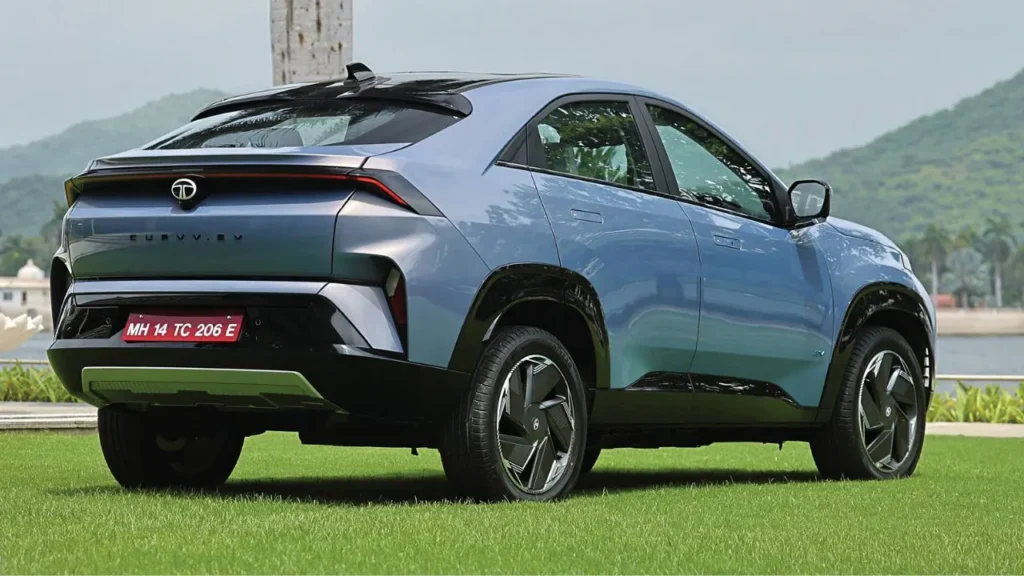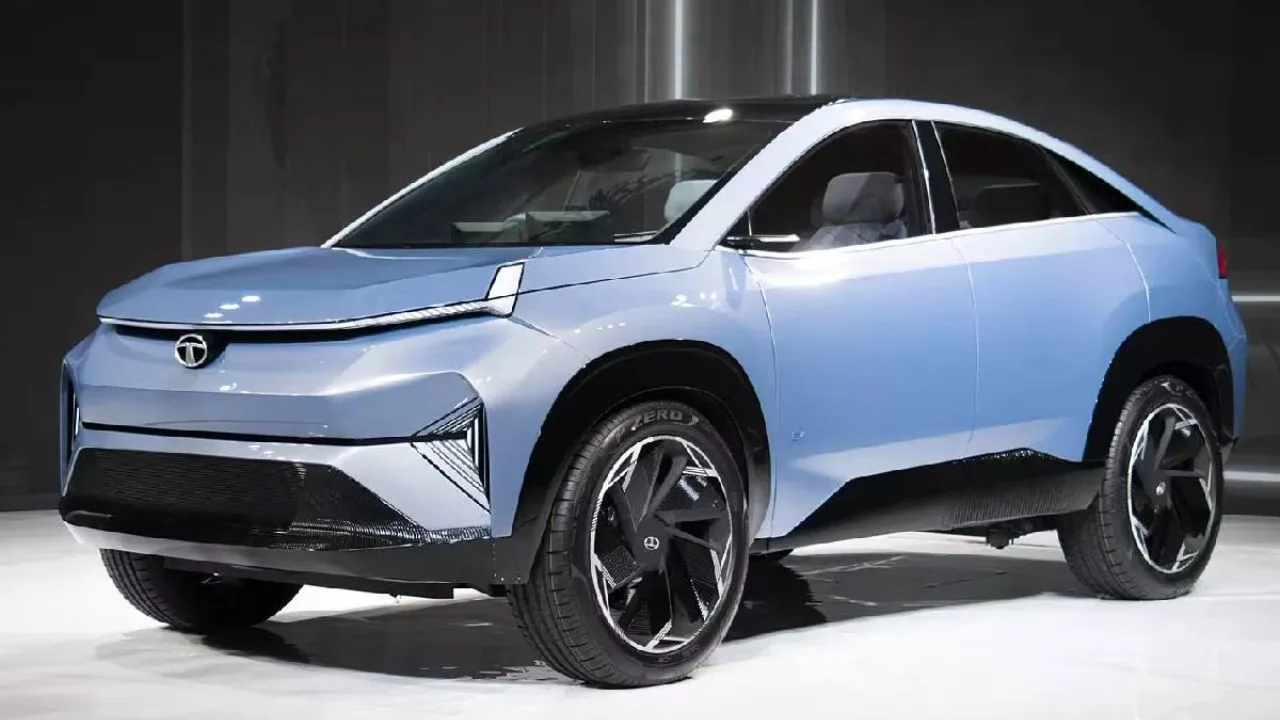Tata Curvv EV vs ICE range comparison: The Tata Curvv has quickly become one of the most talked-about SUVs in India. With its coupe-inspired design and the option to choose between electric (EV) and internal combustion engine (ICE) powertrains, it appeals to a wide range of buyers.
But for most Indian car owners, one big question remains: how far can each version really go on a single charge or a full tank? This Tata Curvv EV vs ICE range comparison looks closely at the real-world numbers, daily running costs, and long-distance practicality to help you make the right choice.
Table of Contents
Tata Curvv EV Real-World Range
The Tata Curvv EV is built on Tata’s dedicated Acti.ev platform and comes with two battery options: a 45 kWh pack and a larger 55 kWh pack. On paper, the 45 kWh battery offers an ARAI-certified range of 585 km, while the 55 kWh pack stretches it further to 615 km.
Also Read- Maruti Suzuki Fronx Hits 5 Lakh Production Milestone in Record Time: Here’s Why It’s a Game-Changer
In real-world Indian driving conditions—where traffic, highways, and air conditioning all affect performance—these numbers are more realistic at 350–450 km for the 45 kWh model and 400–500 km for the 55 kWh version. This makes the EV more than capable for city commutes and intercity trips within a 300–400 km distance.
Tata Curvv 45 kWh vs 55 kWh Battery Range
Choosing between the 45 kWh and 55 kWh battery depends on how you drive. The 45 kWh pack is enough for urban commuters with shorter daily runs, while the 55 kWh version adds extra confidence for highway journeys. Both deliver strong performance with instant torque, but the larger battery also brings quicker 0-100 kmph acceleration at around 8.6 seconds.
Tata Curvv Petrol vs Diesel Mileage
For buyers not ready to make the switch to electric, the ICE variants of the Tata Curvv offer familiar petrol and diesel options.
- The 1.2L Turbo-Petrol (GDi) produces 123 hp and delivers 16–18 kmpl in lab conditions, which translates to around 12–15 kmpl in daily use. This gives a practical range of about 500–660 km on a full tank.
- The 1.5L Kryojet Diesel, with 113 hp and 260 Nm torque, is the most efficient option. With 15–18 kmpl real-world mileage, it can cover 660–792 km on a single fill, making it the best for long-distance travelers.
Tata Curvv EV vs ICE Performance
Performance is one area where both versions have their strengths. The EV delivers instant torque for a smooth and silent drive in the city, while the diesel engine offers strong pulling power on highways. Petrol models balance daily commuting with occasional highway use.

Tata Curvv EV vs Petrol Running Cost
Running cost is a clear win for the EV. With electricity at around ₹8/kWh, the Curvv EV costs roughly ₹1–1.5 per km. In comparison, the petrol model costs ₹6–8 per km, and the diesel costs around ₹5–6 per km depending on fuel prices. Over a few years, this difference in cost per km can add up significantly in favor of the EV.
Tata Curvv EV Charging Time vs ICE Refueling
One advantage ICE vehicles still hold is convenience. Filling a tank with petrol or diesel takes about 5 minutes. For the Curvv EV, fast charging from 10–80% takes around 40 minutes with a 70 kW DC charger, while home charging using a 7.2 kW AC unit can take 6–8 hours.
Also Read- Second-Hand Car Buying Guide India: 10 Smart Steps to Find the Best Used Car
This means the EV works best if you have home or workplace charging access, while ICE variants remain practical for buyers who travel long distances in areas with limited charging stations.
Tata Curvv EV vs Diesel Long Distance Travel
For highway users, the diesel Curvv is unmatched in range and refueling speed. A 700+ km range on one tank and quick refueling make it ideal for long trips. On the other hand, the EV, with 400–500 km real-world range, is sufficient for city-to-city journeys but requires planning for charging stops during longer drives.
Tata Curvv EV vs ICE Maintenance Cost
Maintenance is another factor to consider. The EV has fewer moving parts, which means lower servicing needs and costs over time. ICE models, especially diesel, may require more frequent servicing and higher long-term maintenance expenses.
Tata Curvv EV vs ICE Resale Value
As India’s EV market grows, resale value is gradually improving for electric cars. However, ICE vehicles, particularly diesel, still enjoy stronger resale in semi-urban and rural markets. This balance is expected to shift in the next few years as EV adoption rises.
Tata Curvv EV Range Anxiety Solution
Tata Motors has equipped the EV with features like multiple drive modes and regenerative braking to extend range. In addition, India’s charging network is expanding rapidly in metro cities, helping reduce range anxiety for daily commuters. However, ICE variants still remain more practical in regions with limited charging infrastructure.
Tata Curvv ICE vs EV Ownership Cost
When looking at the total cost of ownership, the Curvv EV is initially more expensive to buy, priced at ₹17.49–21.99 lakh. In contrast, ICE models start at ₹9.99 lakh and go up to ₹18.49 lakh. But thanks to government subsidies, zero road tax in some states, and lower running costs, the EV narrows the gap over time, especially for city users with high daily mileage.
Tata Curvv EV vs ICE: Which is Better in 2025?
The answer depends entirely on your lifestyle.
- Choose the Curvv EV if your daily commute is within 200–300 km, you have easy access to charging, and you want low running costs with zero emissions.
- Pick the Curvv Diesel if you often travel long distances, need strong highway range, and prefer the convenience of quick refueling.
- The Curvv Petrol works best as a versatile option for mixed use in cities and occasional trips.
Final Thoughts
The Tata Curvv highlights how Indian car buyers today have a genuine choice between new-age electric mobility and proven ICE engines. The EV impresses with its 350–500 km real-world range, lower running costs, and eco-friendly drive, while the diesel ICE stands out for its 660–792 km range and highway efficiency.
Also Read- Electric Car Charging Stations in Mumbai: Locations, Prices, and Future of EV Infrastructure
Ultimately, the decision in the Tata Curvv EV vs ICE range comparison comes down to your driving pattern. Urban buyers with regular commutes will benefit most from the EV, while frequent long-distance travelers may still find diesel the more practical option in 2025.
FAQs on Tata Curvv EV vs ICE Range
What is the real-world range of Tata Curvv EV in India?
The Tata Curvv EV offers a real-world range of 350–450 km with the 45 kWh battery and 400–500 km with the 55 kWh battery, depending on driving conditions, traffic, and AC usage.
How does Tata Curvv EV range compare with Tata Curvv diesel?
The Curvv EV real-world range is 400–500 km, while the Curvv diesel can run 660–792 km on a full tank, making the diesel variant better for long-distance travel.
Which is more cost-effective: Tata Curvv EV or petrol?
The Curvv EV running cost is around ₹1–1.5 per km, while the Curvv petrol costs ₹6–8 per km, making the EV far more economical for daily commuting.
What is the Tata Curvv EV charging time compared to ICE refueling?
The Tata Curvv EV charges 10–80% in about 40 minutes with a 70 kW DC fast charger, while petrol or diesel Curvv refuels in just 5 minutes at any fuel station.
Is Tata Curvv EV good for long-distance highway travel?
The Curvv EV can handle 300–400 km intercity trips comfortably, but for long highway drives, the diesel variant is more practical due to its 700+ km range and quick refueling.
What is the Tata Curvv petrol mileage in real-world conditions?
The Tata Curvv petrol delivers 12–15 kmpl in real-world driving, giving a practical range of 500–660 km per full tank.
What is the Tata Curvv EV battery life compared to ICE engines?
The Curvv EV battery is expected to last 8–10 years or 1.6 lakh km, with minimal maintenance. In contrast, ICE engines may require more frequent servicing and higher maintenance costs over time.
Which has better resale value: Tata Curvv EV or ICE?
Currently, Tata Curvv ICE (petrol and diesel) has stronger resale value in rural and semi-urban markets, while Curvv EV resale is improving as EV adoption grows in Indian cities.
What are the pros and cons of Tata Curvv EV vs ICE?
Curvv EV Pros: Low running cost, instant torque, eco-friendly, lower maintenance.
Curvv EV Cons: Higher upfront price, limited charging network outside cities.
Curvv ICE Pros: Affordable starting price, long driving range, quick refueling.
Curvv ICE Cons: Higher running cost, more pollution, higher maintenance.
Which is better in 2025: Tata Curvv EV or ICE?
In 2025, the Curvv EV is better for urban buyers with charging access and high daily commutes, while the Curvv diesel is better for long-distance travelers. The petrol variant suits mixed-use buyers looking for balance.

